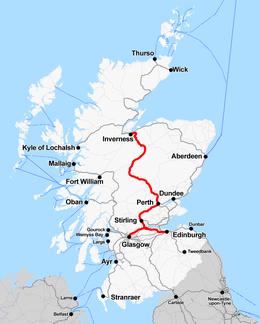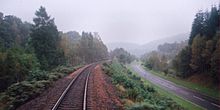| Highland Main Line | |
|---|---|
 Railway map of Scotland showing the Highland line | |
| Overview | |
| Status | Operational |
| Owner | Network Rail |
| Locale | Perth and Kinross Highland Scotland |
| Termini | Perth Inverness |
| Stations | 10 |
| Service | |
| Type | Heavy rail |
| System | National Rail |
| Operator(s) | Abellio ScotRail London North Eastern Railway Caledonian Sleeper |
| Rolling stock | Class 43 "HST" Class 158 "Express Sprinter" Class 170 "Turbostar" Class 73 Mark 5 Sleeping Cars Class 800 "Azuma" |
| Technical | |
| Line length | Perth to Inverness: 118 miles 9 chains (190.1 km) |
| Track gauge | 1,435 mm (4 ft 8 1&fras1;2 in) |
Highland Main Line | ||||||||||||||||||||||||||||||||||||||||||||||||||||||||||||||||||||||||||||||||||||||||||||||||||||||||||||||||||||||||||||||||||||||||||||||||||||||||||||||||||||||||||||||||||||||||||||||||||||||||||||||||||||||||||||||||||||||||||||||||||||||||||||||||||||||||||||||||||||||||||||||||||||||||||||||||||||||||||||||||||||
|---|---|---|---|---|---|---|---|---|---|---|---|---|---|---|---|---|---|---|---|---|---|---|---|---|---|---|---|---|---|---|---|---|---|---|---|---|---|---|---|---|---|---|---|---|---|---|---|---|---|---|---|---|---|---|---|---|---|---|---|---|---|---|---|---|---|---|---|---|---|---|---|---|---|---|---|---|---|---|---|---|---|---|---|---|---|---|---|---|---|---|---|---|---|---|---|---|---|---|---|---|---|---|---|---|---|---|---|---|---|---|---|---|---|---|---|---|---|---|---|---|---|---|---|---|---|---|---|---|---|---|---|---|---|---|---|---|---|---|---|---|---|---|---|---|---|---|---|---|---|---|---|---|---|---|---|---|---|---|---|---|---|---|---|---|---|---|---|---|---|---|---|---|---|---|---|---|---|---|---|---|---|---|---|---|---|---|---|---|---|---|---|---|---|---|---|---|---|---|---|---|---|---|---|---|---|---|---|---|---|---|---|---|---|---|---|---|---|---|---|---|---|---|---|---|---|---|---|---|---|---|---|---|---|---|---|---|---|---|---|---|---|---|---|---|---|---|---|---|---|---|---|---|---|---|---|---|---|---|---|---|---|---|---|---|---|---|---|---|---|---|---|---|---|---|---|---|---|---|---|---|---|---|---|---|---|---|---|---|---|---|---|---|---|---|---|---|---|---|---|---|---|---|---|---|---|---|---|---|---|---|---|---|---|---|---|---|---|---|---|---|---|---|---|---|
| ||||||||||||||||||||||||||||||||||||||||||||||||||||||||||||||||||||||||||||||||||||||||||||||||||||||||||||||||||||||||||||||||||||||||||||||||||||||||||||||||||||||||||||||||||||||||||||||||||||||||||||||||||||||||||||||||||||||||||||||||||||||||||||||||||||||||||||||||||||||||||||||||||||||||||||||||||||||||||||||||||||
The Highland Main Line is a railway line in Scotland. It is 118 mi (190 km) long and runs through the Scottish Highlands linking a series of small towns and villages with Perth at one end and Inverness at the other. Today, services between Inverness and Edinburgh, Glasgow and London use the line. At Inverness the line connects with the Far North Line, the Aberdeen-Inverness Line and services on the Kyle of Lochalsh Line. All trains are diesel-powered.
Much of the Highland Main Line is single track, and trains coming in opposite directions are often timed to arrive at stations at the same time, where crossing loops permit them to pass. Journey times between Inverness and Edinburgh or Glasgow are approximately three and a half hours.[1]
History

The vast majority of the line was built and operated by the Highland Railway with a small section of the line between Perth and Stanley built by the Scottish Midland Junction Railway, amalgamated with the Aberdeen Railway to become the Scottish North Eastern Railway in 1856, and then absorbed by the Caledonian Railway in 1866. Originally, the line between Inverness and Perth went via Forres, but the Inverness and Aviemore Direct Railway was opened in 1898 to allow for a more direct routeing.
There are two significant summits on the line; Drumochter Summit (also spelled Druimuachdar) (elevation 1,484 feet (452 m)) between Blair Atholl and Dalwhinnie,[2][3][4] and Slochd Summit (elevation 1,315 feet (401 m)) between Carrbridge and Inverness.[5] Other distinct features on the route include the viaducts at Culloden and Tomatin, the spectacular mountain pass at Drumochter and the severe gradients encountered in both directions, particularly the extended climb from Inverness to the Slochd summit which averages around 1 in 60 the whole way.
Initially the only double track was between Inverness and Dalcross and also Stanley Junction and Perth. In the 1890s the single line working was improved with the replacement of telegraphing orders to trains along the line with staff and tablet control instruments. This was later upgraded to automatic token-exchange apparatus. However, the main improvement came with the doubling of sections of line, beginning with Blair Atholl to Dalnacardoch (8.25 miles (13.28 km)) in 1900, extended to Druimuachdar (8.5 miles (13.7 km)) in 1901 and Dalwhinnie (5.5 miles (8.9 km)) in 1909.[6] In the 1960s, many sections of the line were converted from double track to single track. In 1976, 23 miles from Blair Athol to Dalwhinie was redoubled.[7][8] In March 2019 Network Rail completed a programme of works to increase capacity on the line and support the introduction of InterCity 125 sets on ScotRail services with passing loops and platforms extended.[9]
Stations and services
As of 2020, there are stations on the line as follows:
| Places served | Ordnance Survey grid references |
| and other notes | |
| Perth | NO112230 |
| Dunkeld and Birnam | NO030417 |
| Shared station | |
| Pitlochry | NN937580 |
| Blair Atholl | NN870653 |
| Dalwhinnie | NN634848 |
| Newtonmore | NN715984 |
| Kingussie | NH756003 |
| Aviemore | NH895123 |
| Connection with Strathspey Railway | |
| Carrbridge | NH899224 |
| Inverness | NH667454 |
Services on the line are provided by Abellio ScotRail and London North Eastern Railway. A roughly two-hourly Abellio ScotRail service operates between Perth and Inverness throughout the day with 11 trains in total in each direction, with all services running from either Glasgow Queen Street (via Stirling) or Edinburgh Waverley (via Kirkcaldy). The London North Eastern Railway service is titled the Highland Chieftain, which departs Inverness at 08:00 and runs to London King's Cross via the East Coast Main Line, arriving in London at 16:00. The return working leaves London at 12:00 and reaches Inverness at 20:00.
The Caledonian Sleeper travels overnight between Inverness and London Euston via the West Coast Main Line. This joins portions from Aberdeen and Fort William at Edinburgh Waverley and south of there forms the longest locomotive-hauled passenger train in the United Kingdom with 16 coaches.
All trains between Perth and Inverness call at Pitlochry, Kingussie and Aviemore. Most ScotRail services call at Dunkeld & Birnam(8 north and 10 south) and at Blair Atholl(8 north and 6 south), with the stations at Dalwhinnie(5 each way), Newtonmore and Carrbridge being served less often. On Sundays, a couple of services continue through to Elgin, calling at Nairn and Forres.[10]
Rolling stock
| Class | Image | Type | Operator | Route | Maximum Speed | Builder/ Built | In Service on the line | Leased From | Other Notes | |
|---|---|---|---|---|---|---|---|---|---|---|
| mph | km/h | |||||||||
| 43 |  | Diesel locomotive | Abellio ScotRail | Glasgow/Edinburgh to Inverness | 125 | 200 | BREL 1975–1982 | 2018 - | N/A |
|
| Mark 3 | Passenger carriage | BREL 1979-1980 | ||||||||
| 73/9 | Diesel locomotive | Caledonian Sleeper | London Euston to Inverness (Takes over from electric loco at Edinburgh) | 90 | 145 | British Railways Eastleigh Works 1962 English Electric 1965-1967 Rebuilt 2014-2016 | 2016- | GB Railfreight | Replaced Class 67 when their lease from DB Cargo UK Expired Class 73/9. | |
| Mark 5 Passenger Coach |  | Lounge car Seated Sleeper Sleeping car | London Euston to Inverness | 100 | 161 | CAF 2016-2018 | Oct 2019- | Caledonian Sleeper Rail Leasing | Replaced the Mark 2s | |
| Mark 5 Sleeper Coach | Replaced the Mark 3s | |||||||||
| 158/0 Express Sprinter | .jpg) | DMU | Abellio ScotRail | Glasgow/Edinburgh to Inverness | 90 | 145 | Derby Litchurch Lane Works 1989—1992 | N/A | ||
| 170/3 & 170/4 Turbostar | Glasgow/Edinburgh to Inverness | 100 | 161 | N/A | ||||||
 | ||||||||||
| Class 800 Azuma |  | Bi-mode multiple unit | London North Eastern Railway | London King's Cross/Edinburgh to Inverness | 125 | 200 | Hitachi Newton Aycliffe 2014-2018 | 2019 - | N/A |
|
Usage
Station usage at some stations remain stable. Overall usage on the line comparing April 2003 to April 2010 has increased 154%.
| Station usage | |||||||||||||||||
|---|---|---|---|---|---|---|---|---|---|---|---|---|---|---|---|---|---|
| Station name | 2002–03 | 2004–05 | 2005–06 | 2006–07 | 2007–08 | 2008–09 | 2009–10 | 2010–11 | 2011–12 | 2012–13 | 2013–14 | 2014–15 | 2015–16 | 2016–17 | 2017–18 | 2018–19 | 2019–20 |
| Perth | 641,822 | 694,527 | 700,509 | 763,415 | 886,748 | 888,586 | 929,282 | 959,310 | 975,364 | 988,795 | 1,077,598 | 1,077,598 | 1,146,000 | 1,081,000 | |||
| Dunkeld and Birnam | 15,406 | 18,810 | 19,339 | 21,897 | 20,856 | 26,010 | 25,436 | 26,178 | 26,506 | 27,862 | 29,924 | 31,050 | 32,022 | 32,878 | |||
| Pitlochry | 66,890 | 84,555 | 88,638 | 78,193 | 78,776 | 97,302 | 87,210 | 87,684 | 90,618 | 98,340 | 101,902 | 112,496 | 121,000 | 121,000 | |||
| Blair Atholl | 8,313 | 11,708 | 11,896 | 10,491 | 10,443 | 11,716 | 11,572 | 13,948 | 12,608 | 14,280 | 14,084 | 16,062 | 16,652 | 17,598 | |||
| Dalwhinnie | 2,066 | 1,619 | 2,013 | 1,774 | 1,975 | 2,644 | 2,208 | 1,894 | 1,984 | 2,172 | 2,472 | 2,460 | 2,392 | 3,188 | |||
| Newtonmore | 4,184 | 5,396 | 6,815 | 6,631 | 7,060 | 8,358 | 7,972 | 9,484 | 9,406 | 8,958 | 8,326 | 8,636 | 9,432 | 8,770 | |||
| Kingussie | 23,815 | 27,725 | 30,045 | 32,135 | 33,416 | 42,618 | 35,838 | 38,544 | 40,298 | 40,954 | 41,408 | 42,522 | 42,850 | 44,200 | |||
| Aviemore | 70,272 | 80,977 | 91,456 | 101,294 | 115,431 | 152,528 | 124,972 | 132,336 | 132,052 | 136,456 | 141,311 | 150,724 | 152,000 | 145,000 | |||
| Carrbridge | 1,531 | 1,910 | 2,987 | 3,954 | 5,438 | 4,232 | 4,500 | 5,118 | 5,636 | 4,454 | 5,540 | 6,256 | 6,898 | 5,808 | |||
| Inverness | 721,358 | 822,928 | 873,011 | 915,840 | 975,569 | 1,407,600 | 1,070,924 | 1,127,718 | 1,180,160 | 1,213,382 | 1,282,445 | 1,303,662 | 1,307,000 | 1,259,000 | |||
| The annual passenger usage is based on sales of tickets in stated financial years from Office of Rail and Road estimates of station usage. The statistics are for passengers arriving and departing from each station and cover twelve month periods that start in April. Methodology may vary year on year. Barking and Blackhorse Road are affected by usage of the ticket gates for the underground and that Gospel Oak connects to the North London Line section of the London Overground and is similarly affected. Barking is further affected by the ticket gates used to access C2C services. | |||||||||||||||||
References
- ^ Highland Main Line timetables at https://www.scotrail.co.uk/sites/default/files/assets/download_ct/edinburgh_glasgow_-_inverness_0.pdf Archived 18 April 2016 at the Wayback Machine
- ^ Yonge, John (December 2007) [1987]. Jacobs, Gerald (ed.). Railway Track Diagrams 1: Scotland & Isle of Man (5th ed.). Bradford on Avon: Trackmaps. map 19B. ISBN 978-0-9549866-3-6.
- ^ Baker, Stuart K. (2015) [1977]. Rail Atlas of Great Britain and Ireland (14th ed.). Addlestone: Oxford Publishing Co. p. 60, section B2. ISBN 978-0-86093-669-5.
- ^ Vallance, H.A.; Clinker, C.R.; Lambert, Anthony J. (1985) [1938]. The Highland Railway (4th ed.). Newton Abbot: David & Charles. pp. 13, 25, 115, 116, 118, 177, 197. ISBN 0-946537-24-0.
- ^ Yonge 2007, map 19D
- ^ Thomas, John; Turnock, David (1989). A Regional History of the Railways of Great Britain. Volume 15 North of Scotland. David St John Thomas. p. 236. ISBN 0946537038.
- ^ Highland doubling The Railway Magazine issue 902 June 1976 page 277
- ^ Highland doubling starts The Railway Magazine issue 905 September 1976 page 476
- ^ Highland main line upgrade work complete Network Rail 28 March 2019
- ^ "Archived copy" (PDF). Archived from the original (PDF) on 18 April 2016. Retrieved 5 April 2016.
External links
- Route on OpenStreetMap
- Highland Main Line on Transport Scotland
- Highland Mainline Community Rail Partnership

